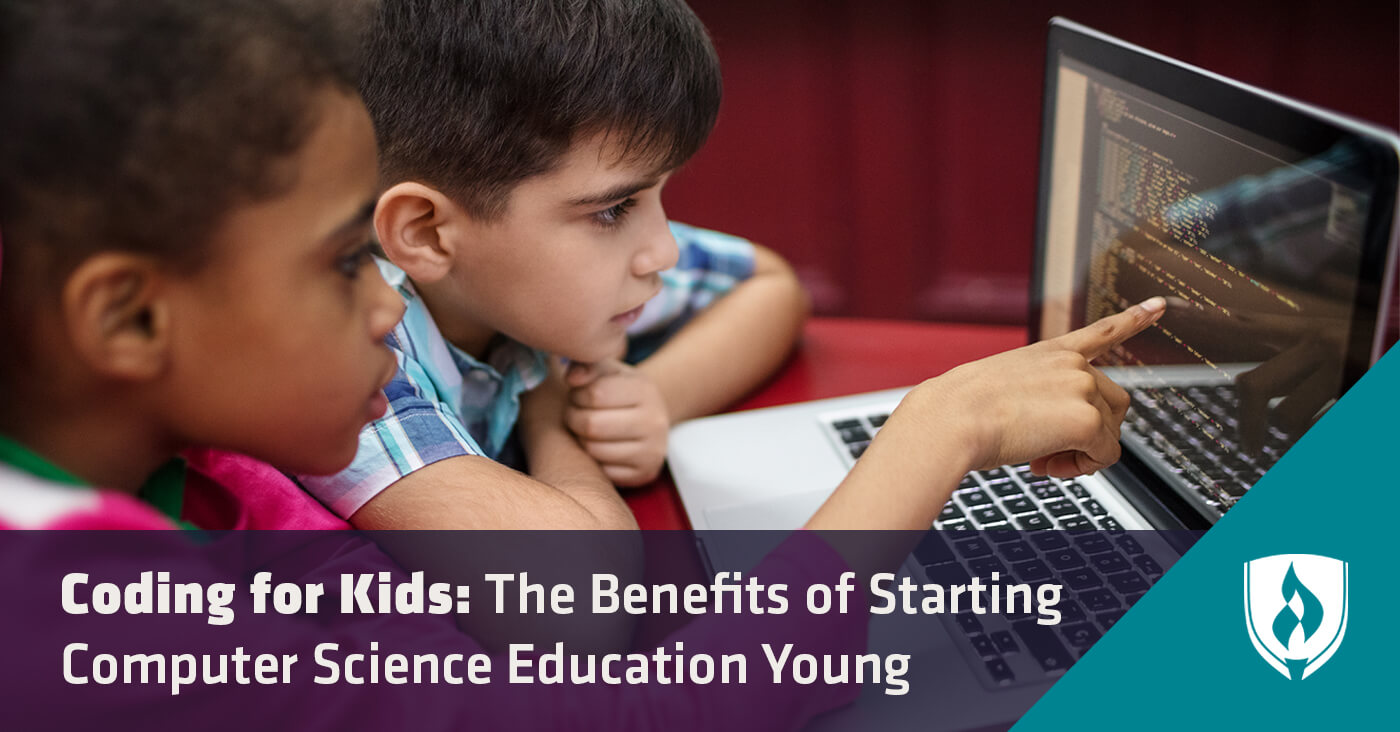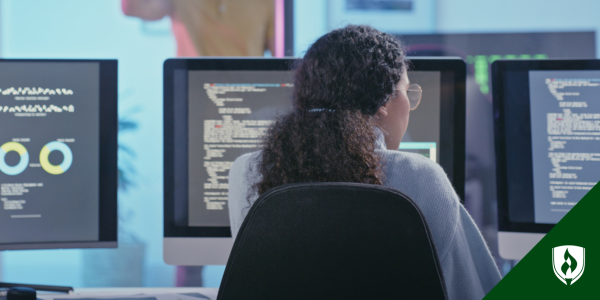Coding for Kids: The Benefits of Starting Computer Science Education Young
By Emily Hayden on 12/01/2016

Scanning a crowded restaurant while your family waits for a seat, you notice almost all of the tables have at least one person staring into a cell phone screen. Walking through the mall involves dodging teens whose eyes are fixated on smart phones rather than oncoming shoppers. You hand your daughter the phone when she gets antsy at the store, immediately transfixing her with a compilation of clips from Disney’s Frozen, so you can discern the best deal on cereal.
Then, at a school meeting for your second grader, the teacher announces the addition of computer science education to the curriculum.
What? Surely we get more than our share of technology use outside of the school day. It’s probably even harmful in these doses.
Though it may surprise you, there are myriad benefits of starting computer science education young. Contrary to common belief, computer coding is not socially isolating screen time. Read on to learn what experts say about the advantages of computer science for our youth.
Learning to code requires thinking and encourages curiosity
Our education system aims to decrease the focus on low-level cognitive development: students sitting back and listening to a teacher dole out facts they will regurgitate later for an exam. As a parent, you know your kiddos are capable of more than memorization, and you’ve witnessed their unbridled energy and curiosity. The great news is that computer science encourages the following types of higher-level thinking:
Computational Thinking
“Coding is not just about creating software. It’s about computational thinking,” explains Gillian Hayes, who has a PhD in computer science and volunteers to teach kids the subject. “Thinking computationally is a benefit to our logic and philosophy skills as well as more traditional STEM (Science, Technology, Engineering and Math) oriented concerns.” There is a direct link between the computing required to code and the computing required in a child’s science and math classes.
Sequential Thinking
Reading comprehension and computer science may not seem related on the surface, especially when you are battling your little ones to put down the tablet and get their nose in a book. But the sequential thinking involved in coding can actually contribute to improved reading comprehension.
The ability to order events in a text relates to the skill of the chronological sequencing required in writing code. So you can rest assured that even if your little one doesn’t grow up to be a computer programmer, exposing them to coding is still benefiting their overall development.
Curiosity
Being curious is motivating for students when approaching a new topic. Instead of regarding technology as magical, coding promotes the question of “Why?” when thinking about a particular app or game. “Young children are exposed to so much technology at a young age, that they miss a vital piece of the puzzle,” says Kimberly Chicchi, computer science teacher at Achievement House Cyber Charter School.“Understanding why something works allows you to put it into context. It’s a beautiful puzzle.”
But what about all the screen time?
Parents and educators fear screen time’s potential to stunt kids’ development. Picturing your child staring into a screen at school seems contradictory to learning.
“Parents sometimes have difficulty telling the difference between students as ‘consumers’ of technology and as ‘producers’ within the technology space.” Lindsey Handley owns and operates ThoughtSTEM, an education startup in San Diego, and she emphasizes that effective computer science classes don’t involve passive consumption. Instead, they encourage creation and teamwork. Check out these engaging coding lessons and activities to use at home or in schools:
- Code.org: A website providing kids the opportunity to design and manipulate a variety of games, create intricate works of art and track mastery of new skills. A multitude of unplugged activities do not even involve a computer.
- Break It Down: Encourage kids to take apart electronics (computers, DVD players, televisions) to see their different components. This process, which Hayes uses frequently with her students, helps kids demystify what is going on under the hood of electronics, just like coding.
- Scratch: A website where kids use code to create animations, music videos, design games, send interactive cards and more. Kids communicate with others throughout the world to collaborate on a project and give design feedback to one another.
- Interactive Robots: Students work on teams in programming robots to complete certain tasks. Encourages problem solving and sequential logic. Sphero and Olliie and Dash and Dot are a couple of examples.
- Makerspace: Community centers are being developed in schools where students use various tools to physically engineer ideas for solutions to problems. They depend on collaboration and critical thinking, and they can be linked to coding.
Coding is crucial to the future
At this point, you may be asking, “What if my kids aren’t interested in becoming computer programmers?” What a waste to emphasize computer science so early when we should prioritize universal skills.
However, learning to code is often compared to learning a foreign language. While the language of coding can be learned in high school and beyond, it is easier and more naturally acquired at a young age.
Early childhood development easily identifies with if/then scenarios, according to Kornel Kurtz, a computer programmer of 30 years and CEO of Webtek. (ie: If you use the potty, then you get a reward. If you tap that icon, this app opens.) “It’s a great introduction to how logical thinking works with programming,” he says. “The younger they grasp that, the easier programming is” His own three children also have programming hobbies and careers.
In our diverse world, people speaking multiple languages in the job market are preferable over those who speak only one. You don’t have to be an official interpreter to benefit from speaking multiple languages.
Similarly, you don’t have to be a computer programmer to benefit from knowing how to code. In fact, computer science and technology currently influence nearly every vocation whether it’s medicine, law, education, farming, political science, business management, construction or marketing.
If your child decides to go into a specifically computer science career, he or she will have an advantage with a multitude of option and exciting earning potential. Computer-related jobs are expected to grow at the faster-than-average rate of 12 percent through 2024, according to the Bureau of Labor Statistics (BLS). The BLS also reports that the median annual salary for these professionals in 2015 was $81,430, which was more than two times the average for all occupations.*
Crack the code while they’re young
It’s understandable if you are hesitant about computer science education for your children. Though it’s not what we remember doing in elementary school, the world is changing and coding for kids is becoming more and more common.
Computer science education enhances our children’s ability to think, engages them with hands-on teamwork and prepares them for a successful future. Who are we to deny them the language their future will rely on?
Find out more about the significant role computer science plays in today’s world in our article: 6 Surprising Ways Computer Science Benefits Society.
RELATED ARTICLES:
- Careers in Computer Science: 4 Facts You Can’t Ignore
- What Can You Do with a Computer Science Degree?
*Salary data represents national, averaged earnings for the occupations listed and includes workers at all levels of education and experience. This data does not represent starting salaries and employment conditions in your area may vary.




